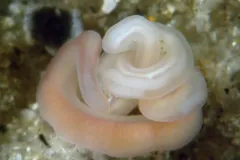The Search for an Elusive Ribbon Worm

With 1,400 named species of ribbon worms inhabiting every ecosystem on earth, seeking one out should be an easy proposition. But I quickly learned that it can be quite daunting when you’re looking for certain teeny-tiny mud-loving worms. I recently accompanied Dr. Jon Norenburg and postdoctoral fellow Dr. Eduardo Zattara, Smithsonian National Museum of Natural History research scientists in the Department of Invertebrate Zoology, on a research trip to Fort Pierce, Florida. The goal? Find ribbon worms (phylum Nemertea) belonging to the genus Carinoma or to the family Hubrechtidae. Members of these particular groups can be found in mud flats around the world.
So why look for Carinoma and Hubrechtidae if they are so hard to find? Jon and Ed sought them out to study regeneration: the ability to grow back body parts. Some nemerteans are very good at regenerating a completely new head and tail, others can only do a tail, and some do not regenerate at all. Why are there differences? And how ancient is the Nemertean ability to regenerate?
The worm groups we were after descended from some of the oldest worms in the Nemertea family tree, which makes them good species to study if you are trying to learn more about the traits of Nemertean ancestors. The researchers expect that by comparing many species, they will learn how regeneration evolved in Nemertea and what genes and molecules underlie this ability. For instance, do they use stem cells? Better understanding of regeneration at such a low level in ribbon worms helps inform regeneration research for more complex species, such as vertebrates (which include us humans). Plus, regeneration is just cool!
 Shortly before low tide, our team headed to a mud flat along the Indian River Lagoon to go digging for ribbon worms. To worm-dig, you first sink your shovel into mud temporarily exposed by the receding water. Then, you push the shovel blade down as far down as you can and slowly pull back on the handle, causing the pocket of mud to crack open. Finally, get your hands dirty by diligently and carefully picking through pieces of mud, looking for the target species.
Shortly before low tide, our team headed to a mud flat along the Indian River Lagoon to go digging for ribbon worms. To worm-dig, you first sink your shovel into mud temporarily exposed by the receding water. Then, you push the shovel blade down as far down as you can and slowly pull back on the handle, causing the pocket of mud to crack open. Finally, get your hands dirty by diligently and carefully picking through pieces of mud, looking for the target species.
I found a worm in my first shovelful! Too bad it was a polychaete—a bristle worm, tiny but not the right species, or even the right phylum! Ribbon worms are quite different and very distantly related to the familiar worms that you find in your garden or a bait shop, which belong to the phylum Annelida. So I continued with my second attempt, and a third, and a fourth shovelful; it was slow work, as most scientific research is. There were plenty of snails, shells, and other worms, but not what we were looking for.
Finally I found a worm of the right size and color—but as soon as I laid my eyes on it, it was gone. These fast worms move quickly through mud and sand; using powerfully developed muscles, they expand and anchor one part of their bodies and rapidly pull the rest toward that. An elaborate system of glands secretes and covers it in mucus to protect the otherwise delicate body wall from abrasion by the sand. Just grabbing them can damage their fragile bodies. When you find one, you can’t just try to pick it up with your fingers— it’s better to carefully grab all the surrounding mud to make sure you don’t break the ribbon worm!
After digging up a whole mud flat, our team found 16 intact specimens and a lot of pieces. (The pieces are still useful because we can study them to see if they’re able to regenerate.) For a day’s work, this may not seem like much. But even if just one specimen is able to regenerate a head or tail in the lab, it will prove that the species does indeed have the ability to regrow body parts.
Stay tuned for more from Eduardo on how these 16 ribbon worms will help scientists better understand regeneration!

